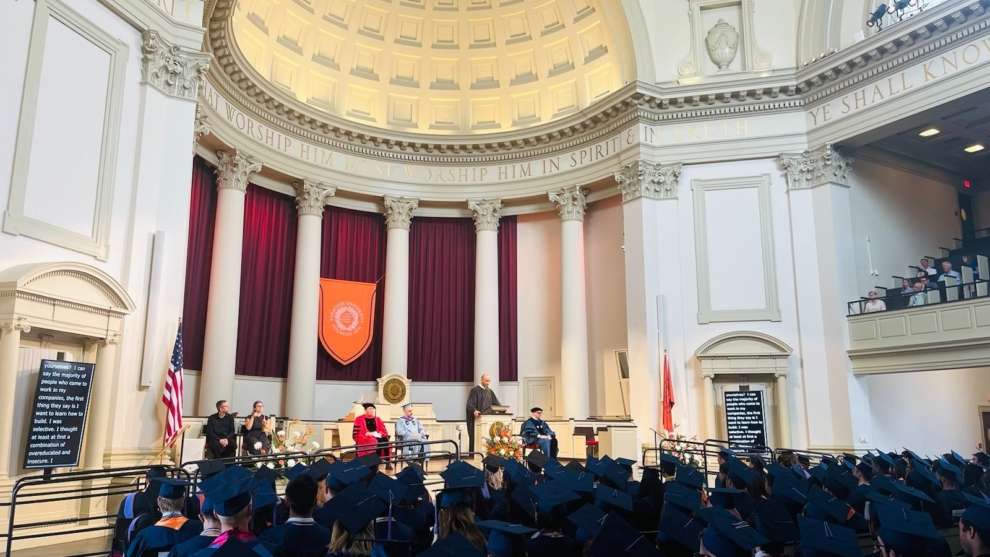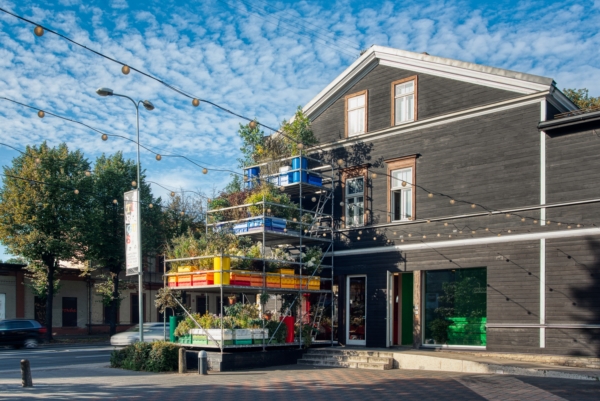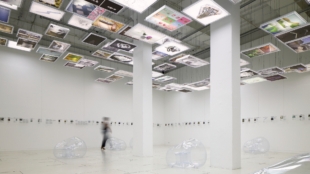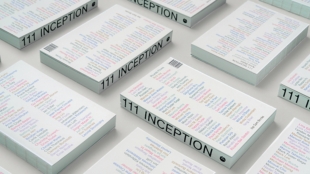Graduates, family and friends, colleagues. I am incredibly grateful and humbled to stand before you on this day, that for you, marks such an incredible achievement. When Dean Speaks presented this opportunity to me—to speak to you, the graduating class of 2022 — I realized the significance of this moment, at this time and place. And, for those of you who know me, with no surprise to Dean Speaks, I made a counter proposal. Only then did I understand that I had been waiting for this opportunity. So, instead of speaking solely to the graduating class, I want share some reflections with everyone here today, especially those of you that are not architects or designers, yet impacted by what we do.
You make ask Why do that?
Because those not directly connected to the profession of architecture do not know what We in the profession ACTUALLY do. There is a disconnect between expectations and
understanding. For too long we have found comfort in our self-constructed echo chamber. And not only that, those who do understand question WHY we do what we do.
So, the first part of my talk today is for the parents and friends who have joined us today. My intention is not only to provide some insight about what architects do, but also (and somewhat surreptitiously) to provide each of the you, the graduates, the agency to explore architecture as cultural practice.
Today I will be detailing several personal stories, something which in other contexts, or at other schools, would be normal, even expected. But unfortunately, this is not the case for architects, nor for schools of architecture. We (and by We from this point forward I mean graduates + architects) are educated to be non-personal. Understandably ironic and antithetical.
We are both intellectuals and technicians, artists and engineers, social anthropologists, and policy makers—we range across and oscillate between disciplines and professional areas of practice. The complexity of what we do often obfuscates the simplicity of it. Moreover, what we do is changing, especially as we, architects, respond to the many challenges that confronts the world today. And perhaps the most notable change is the shift that is occurring in architecture as a discipline and profession from a practice where the architect is concerned mostly with buildings to one where the architect is a facilitator of ideas and methods for approaching the world.
Architects builds culture.
First, some context. When I 12 years old, living in Newark, Delaware (having the inner city only to be subject to desegregation), I had a
drawing assignment on the subject of architecture and interior design. I was given a light green sketchbook with lined pages, and I went to the University of Delaware campus near my home. No one asked me any questions, and I proceeded to sketch lintels, columns, doors, patterns, chairs with claws on the feet, urns over the doors. I supplemented this with pictures I cut out from magazines. When finished, I gave the report to my teacher – I remember she would scare us with threats of kissing us if we did not behave and it worked – and I said, “I am going to be an architect.” That was the first and only time I had sketched anything before studying at the University. During the summers in high school, I studied Math and Journalism – not knowing the value this would add to my future studies. When the time came to apply for University, my parents asked me what I intended to study, and I answered with the utmost surety that “I was going to be an architect.”
They smiled in disbelief. I was a 17-year-old, African American, soccer player, fortunate to be able to attend University on an athletic scholarship, entering a profession grossly underrepresented by people of color. I am grateful to stand before you today.
Parents and friends, Architecture school is not about architecture as the general public understand it. Architecture school is a culture that binds this group of people together. These students, faculty, and staff, together. It is a culture that enables them to see through a different lens. An equitable one, a spatial one, a collective one. It is a culture that educates us to appreciate and make use of unexpected relationships and connections within the frame of making.
Architects are Makers.
We make relationships; we make frameworks for communication; we make equitable space — low threshold space that engenders the diversity that releases our humanity.
As a parent or guest, think for a moment about architecture: about houses you have lived in, places you have worked, public spaces, a room, a shelter, a lodge, a bathhouse, a museum.
And then try to delaminate your visual memory of space and place and consider for a moment what one of those spaces DOES for You, what it GIVES You, what it ENABLES in you, and what it SAYS about you. That is what We do. We enable spaces and places to communicate with you: to enliven and animate what is known as well as what is unpredictable and unknown. Architecture facilitates our immersion into the experience of space. And the more committed We are to this idea the more powerful that experience becomes.
The visual impact of architecture is absolutely important — it is what most of us think about when we think of architecture. But there is much more. Architecture is unfathomably challenging. And incredibly powerful.
Architecture school is a rigorous study that covers more material than can be completely absorbed in 5-years. Followed by professional licensing, which is hard, requiring a rigorous process of checking boxes to ensure that you can manage the massive responsibility professional practice brings with it. Building is infernal. A sundry of codes that vary from place to place, country to country, norms, standards, specifications, contractors with varying standards and approaches; clients, who don’t always understand what we do, engineers with varying degrees of motivation and support (but whose expertise, unlike ours, is engraved in stone), city officials who combine protocols and checklists with personal reflections on top of ours.
This what We do. Now for the graduates, I want to talk about WHY we DO what WE DO.
Architecture is EASY (being an architect is not).
When I finished University, there was a recession – in retrospect I have convinced myself that it was a recession without any substantiating data except 120 unanswered job applications split between Los Angeles, New York, Chicago, and Philadelphia. My debt-to-income ratio was daunting. I needed a job. I convinced myself that I needed to learn how to build (do you hear yourselves?). I was selective, I thought. at first. A combination of overeducated and insecure. I wanted to BE something that in all honesty was a moving target. Every time I thought I knew what Architecture was, I discovered it was something else. I saw myself as a generalist in a specialist field and a specialist in a generalist field. In one form you are all specialists. You are experts in equitable communities, industrial design, new materials, coding, environmental strategies, decolonization, cultural geographies, circular economies, and systems thinking in design.
Obfuscated by all my predispositions about the profession, focused on working a maximum amount of hours to substantiate my resolve, and to solve problems that were not even asked, I now can tell you why architecture is in fact easy. It is, as so many things in life, built around one simple idea – listening. Listening as a reciprocal, connective, and incredibly virtuous affair. This connects all of us here today.
I want to come back to the idea of specialist. And I want to start with a simple anecdote. Let’s say you injure yourself, playing a sport. An injury that clearly requires medical attention. You google and the algorithms for your profile lead you to a conclusion: a right knee, ligament tear. Now imagine going to a doctor, and explaining your injury, followed by telling the doctor he should give you platelet-rich plasma injections, explain the time-frame for him to do his work, and the budget. The doctor, would, for all intents and purposes smile and politely (or not so politely) ask you to leave his office. Now most of us can agree that a doctor has what can be called asymmetric knowledge. His knowledge is unequal to ours, not unlike an engineer in our profession.
I would like to challenge this notion. We too have asymmetric knowledge. Granted, it has been threatened, even sidelined by developers, contractors, and clients, but now, and I mean especially now, your unadulterated knowledge (knowledge, not experience) is some of the best and most relevant information available today. And knowing this, understanding this, is invaluable to your success.
Circling back to knowledge, a topic which I am especially fanatical about, recently had a conversation with my closest, non-architect friends, about experts/specialists and generalists. I proceeded to ask each one if they considered themselves an expert. They concluded that expertise is a function of time. Focusing on specific problems, delighting in detail, and going very deep in understanding the deterministic rules of cause and effect. They were of ages, like me, and they considered themselves experts in their fields.
The writer Malcolm Gladwell as well as numerous other researchers (particularly related to sports – which is more easily quantifiable) have cited the 10,000-hour rule – that rule being the ‘exact’ amount of time it takes to master a skill. To be a specialist. So, for this occasion, I ran the numbers for you. At 8 hours a day, 6 days a week, 30 weeks in a school year, and 5 years for your bachelor’s degree. That would put everyone here at 7,000 hours. If you add graduate school which many of you will complete, you will easily eclipse the 10,000-hour mark. And yet, I will argue here today, that despite what you may believe or, as in my younger self, hope for, you will remain generalists.
And that is exactly where We are supposed to be.
We answer wicked problems. Problems that are ‘nearly’ impossible to solve; incomplete problems, problems that change in scope and
condition. And that is where our asymmetric knowledge is transformative – You can see conceptual and structural patterns between seemingly unrelated ideas and environments, and the abstract mechanisms behind them. You have what David Epstein refers to in the book with the same name, Range. Moving between disciplines, navigating challenging problems and uncertainty, asking the right questions, and making associations through interdisciplinary thinking. We merge the specialist information into new constellations and configurations.
I would ask you to take this with you today: avoid cognitive entrenchment. Embrace ambiguity. And furthermore, do not only answer the wicked problems, ASK the wicked questions.
When I worked at The Office for Metropolitan Architecture – otherwise known as OMA –
with Rem Koolhaas, there were two clear ‘fronts’ at the office, the experts and the juniors or interns. The experts were old (albeit younger than I am now), experienced (we assumed), and unbearably sure of themselves. And why shouldn’t they be, they had done extraordinarily complex projects with great success. Their gray hair, glasses, and insolent expression were their tell. The interns on the other hand were young, brash, insultingly naïve (in the eyes of the experts) and overwhelmed with impatience. The juniors thought the experts were dull and inflexible, their ideas dated and uninteresting. The experts’ thought the juniors were wasting their time and the company’s money, and ultimately, they were only making the slow even slower. And then there was Rem. And his powerful intellect, combined with his youthful energy and impervious curiosity. Rem had this incredible ability to curate any conversation to ensure the interns and juniors had a voice. He demanded it. He knew their value. He understood they did not have all the answers, but with their inspiration and freedom of thought he was able to formulate new, better questions, the answers to which would be solved Together. The office was dependent on this youth, and its success was Rem’s ability to see it and catalyze it.
I was at that time in many a conversation with Ove Arup, one of the preeminent engineering companies in the world. I can recall one specific session where I presented sketch after sketch of a new skyscraper to their team of structural engineers – experts. I ignored the snickers not so subtly directed at me. Rem looked on confidently. After 7 or 8 fails I posed a question, in the form of a sketch – What if we did this? – and the room was silent. The engineers mumbled. Rem smiled. Laughter erupted. And we had arrived at the design for a new super skyscraper. What would be at the time, if realized, the world’s tallest building. I was 27-years old, leading a multidisciplinary team, specialists, on a high-rise development and masterplan in Seoul, Korea for OMA.
We are experts in contemporary culture (and theory), idea management, and process curation.
For some, education is a means to an end. But for those fortunate of you, education will be endless. Many of you will be so fortunate as to be surrounded by researchers, academics, practitioners, social anthropologists, politicians, economist, geologists, artists, and a multitude of other brilliant individuals challenging the status quo. Which brings me back to the dichotomous condition of specialist and generalist.
We are both.
Architecture is SLOW.
And in many ways, it should be slow. In Norway where I have worked the past 20 years, the social democratic process is dependent on slowness. Slow is inclusive. Slow is reflective. Slow is adding value throughout. Slow is iterative.
School is fast, and the speed is intoxicating. A speed that is impossible to replicate outside of this elaborate consolidation of intelligence and potential. Prepare yourself for slow. Embrace it as you would any journey, with the people, and challenges that come with a highly collaborative process. The slowness gives us the latitude to translate our ambitions into a conversation. A conversation that may translate itself into an experience. An experience that may be understood as architecture. And this takes time.
Architecture is Changing.
My son is applying for graduate school in architecture. He was accepted to two of the best programs today in architecture. Without enthusiasm or celebration. Arguably a generational difference, one which you yourselves might be familiar with – back to the question of WHY, one of the questions I started this talk with. I needed to unpack his uncertainty, as it was unsettling. Understanding the current profession is increasingly difficult, even for those of us immersed in it, though this was not the reason for his doubt. Excavating this uncertainty, the answer came down to one simple thing – although difficult reflection for me to share – while he clearly remembered my struggles, projects, clients, collaborations, he could not remember my joy. And while he was not worried about me personally, as he experienced my joy in a multitude of other
forms, but he was in fact genuinely worried about the profession.
There should not be any illusion that the adversity that the world has collectively experienced over the past 5 years, is moving architecture into a more open space. Architecture is on a precarious precipice, one which it may have to succumb to, to enable the unique insight and skill YOU possess as architects. I am advocating for a distinction between architecture as a service and the architect as a facilitator and curator of information. And I want to be clear, the profession in many ways is not ready for what your education at Syracuse University has provided you with. It continues to struggle with its own residual self-image, as well as with ideas of equity, diversity, inclusion, culture, sustainability, community, and race. You are educated under the auspices of this future. And while architecture is SLOW, you are NOT. You have more skills, more knowledge, more information, more resilience, more tools than any generation of architects before you. You only need to remember you are not architecture, you are an architect.
Architecture is together.
As Nicolas Bourriaud, author of Relational Aesthetics describes, this world consists, not only of things, signs, and forms – this world is held together by interpersonal relations that form the ultimate source and object of inspiration and creative work.
A large part of your education has been overshadowed by a devastating pandemic that has caused immeasurable loss, instability, and disruption in our lives. Yet, as you look at yourselves, remember, your resilience and resolve, and that of the people close to you, an unmatched humanity is the force behind what we all imagine as an imminent, systemic change.
If you were to watch season after season of commencement speeches, the changes would be minimal, unnoticeable even. However, if I look back to where the profession was in 1990 when I graduated from Virginia Polytechnical and State University, the differences would be of a dizzying magnitude; decolonization, mapping social inequity, climate change, energy, cultural geographies, and geopolitical forces in architecture were NOT part of the conversation. We did not reflect on the multiplicities of intersections within academics, nor connections to diverse professionals that you have had, in expanding the knowledge of our profession. Your education has been as much about the unlearning of architecture while building new foundations for a just and equitable planet. The profundity of your thinking, a reflection of the social imperative that has encircled us, your ability to make visible, what has been blurred for generations, while forming a critical spatial practice is inspiring. You are the ones we will be watching.
Architects builds Culture.
Architects Make.
Architects are Special Generalists.
Architecture is Slow.
Architecture is Easy.
Architecture is Together.
Parents, friends, guests, you are essential to this journey. You will need from time to time to extract them from the rabbit hole and remind them of their core values, remind them of the power of culture. Meanwhile graduates, look at your peers, those next to you, THIS is your community, your extended family. And trust me, you will need them. Be
generous to each other because we are all trying to do something nearly – nearly – impossible. Be supportive, because each of you are part of a generation of makers, and you will need the support and belief to make a more equitable, sustainable future. Be present in this moment, and all the moments ahead. I could not have imagined that when I was where you are now, in Blacksburg, Virginia, that Bill Price, the Brown endowed chair at Prairie View A + M, radical in his subjugation of the normative for the pursuit of the formative would join me at OMA and change the landscape of research in materiality and design in architecture. Or that my friend and colleague Bjarke Ingels would become BIG. And Joshua Ramus of REX, the godfather of my son (and architect behind the new performing arts center at ground zero). And Dan Wood and Amale Andraos forming Work AC and the latter becoming the Dean of Columbia University. Or that Jacob van Rijs and Winy Maas, together with Nathalie De Vries would start an architectural revolution in the Netherlands that Dean Speaks would so brilliantly capture in what he called Big Soft Orange. And that those same, seemingly unconnected conditions and relationships brought Dean Speaks and me together, lifelong colleagues, and now, standing in front of you as your colleague, a member of this unique tribe, giving the most important talk of my career.
Lastly, I would like to close by quoting the person currently most impacting my thinking, and who is today in the audience with us, my wife, Anna Bates:
Our approach is not to claim the author is dead (referencing Michael Foucault, who again was referencing Nietzsche), but keeping our authorial narcissism in check and accepting creation for what it has always truly been; an act made possible by a multitude of ideas,
techniques, insights, and statements drawn from a rich and diverse cultural field spanning generations.
There is much to do. I propose that we do it collectively.
Thank you, Syracuse University.
Thank you Dean Speaks, parents, friends, guests, colleagues, and most importantly, thank you graduating class of 2022.



